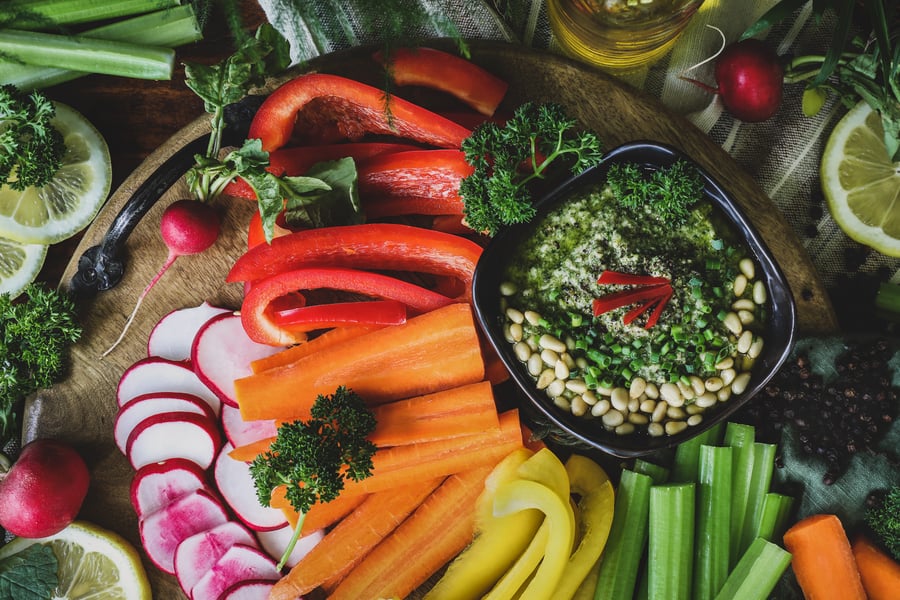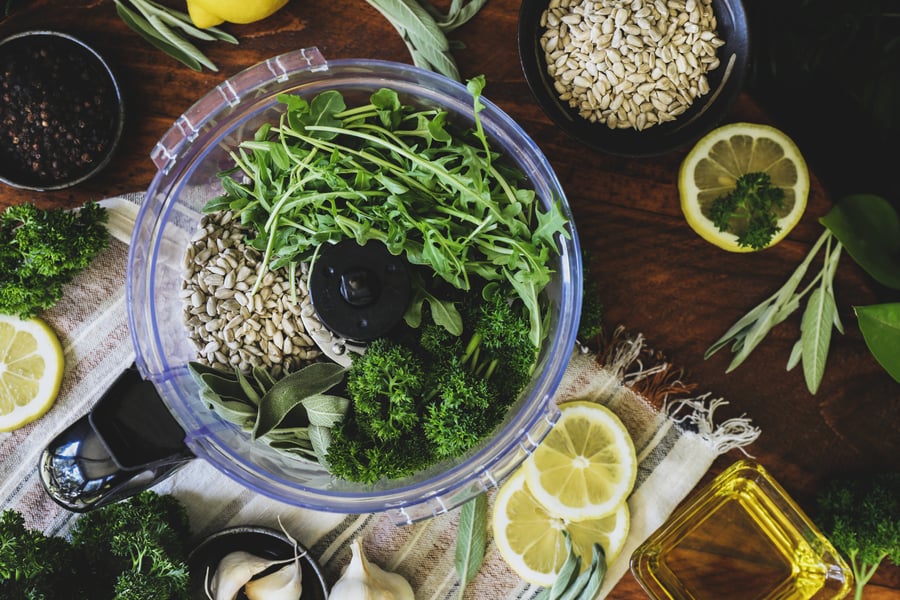Research compiled by Oregon State University has shown that roughly half of the adult population in the United States doesn’t get enough of the vitamins and minerals that leafy greens supply: 52% don’t get the recommended intake of magnesium, 44% don’t get enough calcium, and 43% don’t get enough vitamin C. Although many of us know that we need two to three cups of leafy greens a day to supply our exquisitely complex bodies with the vitamins and minerals needed to carry out cellular processes and repairs, many of us have trouble eating adequate amounts of those greens.
Enter… pesto! Pesto is an herbally delicious way to fuel our daily eating rituals with greens that are rich in vitamins A and C, as well as magnesium, calcium, and more. In addition to the flavor and nutrients pesto brings to a meal, adding fresh herbs to cooked food also helps our bodies improve nutrient uptake by increasing digestibility. Raw leafy greens support the production of enzymes and probiotics in the gut, helping catalyze digestive processes. And when you have pesto on hand, it’s easy to top any cooked food with fresh greens.
In my house we have a bit of a joke about the elements—there is earth, water, fire, air, and pesto!
First, Think Beyond Basil
Although the most commonly known pesto tradition revolves around basil, pesto isn’t exclusive to any herb. The word comes from the Latin verb pestare, “to pound,” and shares a root with “pestle.” Pesto is simply the process of crushing herbs and nuts into a deeply satisfying sauce. We can think beyond basil and use the various greens available to us depending on the season.
I make a batch weekly—which takes approximately 20 minutes—and keep it in the refrigerator, ready to complement any meal. Life is just better when you have a batch of seasonal pesto in the fridge! You’ll find that when it’s there, it gets eaten. If you don’t want to do it every week. Double the batch and put half in the freezer to pull out for next week.
Use it to top your eggs or avocado toast. Slather it onto bread for a sandwich or for any time you’d think of using mayonnaise. Mix it into a potato or rice dish, set a small bowl next to veggies as a dip, or add vinegar to turn it into a salad dressing. Use your imagination to find a place for a dollop of pesto on your plate.
How to Create Your Own Pesto Recipe Template
With three decades of passion for pesto in my kitchen, I’ve devised a set of guidelines that routinely produce great pesto. You can follow this template and plug in the seasonal leaves and herbs you find in your garden or at the farmer’s market.
Basic Pesto Proportions
Ingredients
- 1/2 cup organic nuts/seeds (sunflower, pumpkin, walnut, pistachio, pine nut)
- 2 Tbsp. organic lemon juice
- 2 organic garlic cloves, peeled
- 1/2 - 3/4 cup organic olive oil
- 1/2 - 1 cup water or organic vegetable broth (optional depending on preferred consistency)
- 3 cups fresh organic greens
- Up to 1/2 cup of other ingredients from the spicy, sour, savory, or vegetable category (find inspiration below)
- Optional seasonings (to taste)
- French gray salt, garlic salt, or salt of choice (to taste)
Directions
- Put nuts/seeds, lemon juice, garlic, and half the olive oil into a blender.
- Add an optional 1/2 to 1 cup water/broth for added creaminess, depending on how thick, chunky, or smooth you like your pesto.
- Blend well.
- Add all leafy greens, herbs, spices, vegetables (if using), and the remaining olive oil.
- Blend until you reach desired consistency, adding more water or broth as needed.
- Adjust salt, seasonings, and add-ins to taste.
- Put into a clean jar, label, and store in the refrigerator for up to 7 days.
Fresh Leafy Greens to Add to Pesto: Arugula, basil, cilantro, parsley, salad mix, fresh spinach, or spring chickweed. I always mix several of the leafy greens because they are considered vegetable servings.
Savory and Herbal Ingredients for Pesto: These ingredients add a heightened dimension of flavor to pesto, but if you don’t mix them with some green leafy herbs, the pesto becomes overwhelmingly bitter or spicy. Some examples include chervil, chives, dandelion leaf/flower, fennel fronds, garlic chives, garlic scapes, jalapeno, lavender, lemon balm, mint, mustard greens, nasturtium leaves and flowers, oregano, purslane, peppermint, rosemary, sage, savory, sorrel, tarragon, thyme, watercress, miso paste, and tamari.
Spicy and Sour Ingredients to Include in Pesto: Add some zing to your pesto with one of the following optional ingredients in small amounts: balsamic vinegar, capers, fresh ginger, fresh horseradish, Greek olives, hot pepper, or white wine vinegar.
Vegetables for Pesto: Cucumber, chard, fennel root, fresh or dried tomatoes, kale, mizuna, red bell peppers, red onions, scallions, and tomatillo.
Optional Seasonings:
- Paprika powder
- Ancho pepper powder
- Cayenne powder
- Chive rings
- Shiitake powder
- Sumac berry powder
- Lemon pepper
- Lemon peel powder
- Garlic and herb seasoning
- Garlic pepper
Spring Pesto Recipes
If you haven't been eating enough greens over the winter, spring is the perfect opportunity to reset and get those leafy greens in your meals! Cultures around the world emphasize eating greens in spring, as leaves are one of the first foods to burst joyfully from the warming earth.
Spring greens spur the body’s natural detoxification processes. This is especially true of bitter greens, which stimulate the liver to produce bile and carry waste out of the body. Note that I rarely add cheese to pesto and find that the flavor is just as good without it. Omitting the cheese allows us to really focus on eating greens without having to worry about the possible congesting nature of excess cheese.
In honor of spring, here are two of my favorite spring pesto recipes for health and vitality. They feature greens that are readily available in this season, whether you find them in your garden, growing wild, or at the local farmer’s market.
Dandelion Chive Pesto
Many of my students with German and Swedish ancestry have talked of their grandmother’s spring dandelion dishes. There is deep wisdom in bitter dandelion greens eaten as a spring tonic, supporting the liver and clearing out winter stagnation.
Ingredients
- 1/2 cup organic pistachio nuts
- 2 Tbsp. organic lemon juice
- Zest from 1 organic lemon
- 2 organic garlic cloves, peeled
- 1/2 - 3/4 cup organic olive oil
- 1/2 - 1 cup water or organic vegetable broth (optional)
- 1 cup fresh organic dandelion greens/flowers
- 1 cup fresh organic spinach
- 1 cup fresh organic salad mix or mild lettuce greens
- 1/4 cup chopped fresh organic chives
- French gray salt, garlic salt, or salt of choice (to taste)
- Herbs and spices from the tasty add-on list in basic recipe above.
Directions
- Follow Directions in Pesto Recipe above.
Arugula Sage Pesto
Arugula is a peppery, slightly bitter green that loves cool spring weather. Sage is a cold-hardy herb that will be sending out new leaves at the turn of the season. Both of these herbs have carminative properties that support digestion and are the perfect addition to a spring meal.
Ingredients
- 1/2 cup organic sunflower seeds
- 2 Tbsp. organic lemon juice
- 2 organic garlic cloves, peeled
- Dash of freshly ground organic black pepper (or to taste)
- 1/2 -3/4 cup organic olive oil
- 1/2-1 cup water or organic vegetable broth (optional)
- 2 cups organic arugula
- 1 cup fresh organic parsley
- 1/4 cup fresh organic sage
- 2 Tbsp. chopped dried tomatoes, optional
- Tamari, French gray salt, garlic salt, or salt of choice (to taste)
- Herbs and spices from the tasty add-on list in basic recipe above.
Directions
- Follow Directions in Pesto Recipe above.
I hope these recipes bring joy, nutrition, and delicious meals to your table as you experiment with greens in the kitchen. It might feel like a small thing, but seemingly tiny actions like making and eating pesto will, over time, add up to a larger shift toward wellness. Beyond strengthening our individual health, weaving new traditions with nourishing, seasonal foods helps us create a shared culture of wellness, the effects of which ripple and grow for generations to come. Here’s to the healing tradition of pesto!
Want Even More Pesto in Your Life?
Check Out This Fresh Nettle Pesto!
You may also enjoy:
- Spring Nettle & Garlic Buttermilk Biscuits
- Welcome Spring by Moving Liver Qi
- Working With Herbs in the Rhythm of Nature














